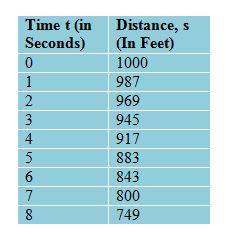
Instantaneous Velocity on the Moon Neil Armstrong throws a ball down into a crater on the moon. The height (in feet) of the ball from the bottom of the crater after seconds is given in the following table:

(a) Find the average velocity from to seconds.
(b) Find the average velocity from to seconds.
(c) Find the average velocity from to seconds.
(d) Using a graphing utility, find the quadratic function of best fit.
(e) Using the function found in part (d), determine the instantaneous velocity at second.
To find: Instantaneous Velocity on the Moon Neil Armstrong throws a ball down into a crater on the moon. The height (in feet) of the ball from the bottom of the crater after seconds is given in the following table:

a. Find the average velocity from to seconds.
Answer to Problem 49AYU
Solution:
a.
Explanation of Solution
Given:

Calculation:
a. The average velocity from to is,
To find: Instantaneous Velocity on the Moon Neil Armstrong throws a ball down into a crater on the moon. The height (in feet) of the ball from the bottom of the crater after seconds is given in the following table:

b. Find the average velocity from to seconds.
Answer to Problem 49AYU
Solution:
b.
Explanation of Solution
Given:

Calculation:
b. The average velocity from to is,
To find: Instantaneous Velocity on the Moon Neil Armstrong throws a ball down into a crater on the moon. The height (in feet) of the ball from the bottom of the crater after seconds is given in the following table:

c. Find the average velocity from to seconds.
Answer to Problem 49AYU
Solution:
c.
Explanation of Solution
Given:

Calculation:
c. The average velocity from to is,
To find: Instantaneous Velocity on the Moon Neil Armstrong throws a ball down into a crater on the moon. The height (in feet) of the ball from the bottom of the crater after seconds is given in the following table:

d. Using a graphing utility, find the quadratic function of best fit.
Answer to Problem 49AYU
Solution:
d.
Explanation of Solution
Given:

Calculation:
d. Using a graphing utility, find the quadratic function of best fit.

The quadratic function is .
To find: Instantaneous Velocity on the Moon Neil Armstrong throws a ball down into a crater on the moon. The height (in feet) of the ball from the bottom of the crater after seconds is given in the following table:

e. Using the function found in part , determine the instantaneous velocity at second.
Answer to Problem 49AYU
Solution:
e.
Explanation of Solution
Given:

Calculation:
e. The instantaneous velocity of is the derivative : that is,
Replace by . the instantaneous velocity of the ball at time is,
The instantaneous velocity at is,
Chapter 14 Solutions
Precalculus
Additional Math Textbook Solutions
University Calculus: Early Transcendentals (3rd Edition)
Glencoe Math Accelerated, Student Edition
Calculus & Its Applications (14th Edition)
Calculus, Single Variable: Early Transcendentals (3rd Edition)
Single Variable Calculus: Early Transcendentals (2nd Edition) - Standalone book
Thomas' Calculus: Early Transcendentals (14th Edition)
 Calculus: Early TranscendentalsCalculusISBN:9781285741550Author:James StewartPublisher:Cengage Learning
Calculus: Early TranscendentalsCalculusISBN:9781285741550Author:James StewartPublisher:Cengage Learning Thomas' Calculus (14th Edition)CalculusISBN:9780134438986Author:Joel R. Hass, Christopher E. Heil, Maurice D. WeirPublisher:PEARSON
Thomas' Calculus (14th Edition)CalculusISBN:9780134438986Author:Joel R. Hass, Christopher E. Heil, Maurice D. WeirPublisher:PEARSON Calculus: Early Transcendentals (3rd Edition)CalculusISBN:9780134763644Author:William L. Briggs, Lyle Cochran, Bernard Gillett, Eric SchulzPublisher:PEARSON
Calculus: Early Transcendentals (3rd Edition)CalculusISBN:9780134763644Author:William L. Briggs, Lyle Cochran, Bernard Gillett, Eric SchulzPublisher:PEARSON Calculus: Early TranscendentalsCalculusISBN:9781319050740Author:Jon Rogawski, Colin Adams, Robert FranzosaPublisher:W. H. Freeman
Calculus: Early TranscendentalsCalculusISBN:9781319050740Author:Jon Rogawski, Colin Adams, Robert FranzosaPublisher:W. H. Freeman
 Calculus: Early Transcendental FunctionsCalculusISBN:9781337552516Author:Ron Larson, Bruce H. EdwardsPublisher:Cengage Learning
Calculus: Early Transcendental FunctionsCalculusISBN:9781337552516Author:Ron Larson, Bruce H. EdwardsPublisher:Cengage Learning





